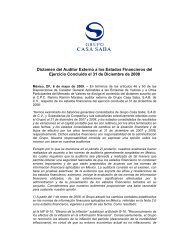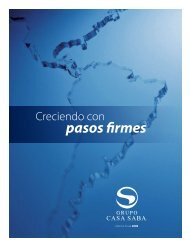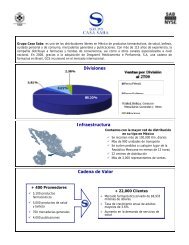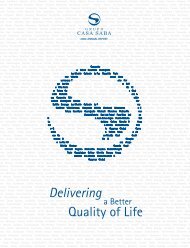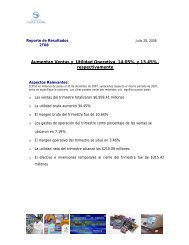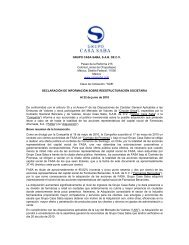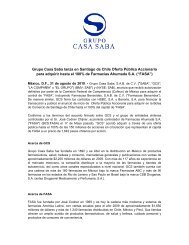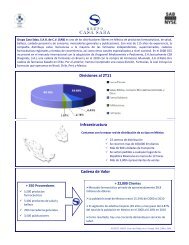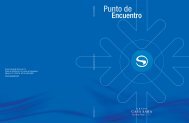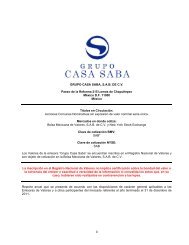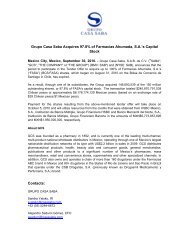FORM 20-F Grupo Casa Saba, S.A.B. de C.V.
FORM 20-F Grupo Casa Saba, S.A.B. de C.V.
FORM 20-F Grupo Casa Saba, S.A.B. de C.V.
Create successful ePaper yourself
Turn your PDF publications into a flip-book with our unique Google optimized e-Paper software.
Table of Contents<br />
● In October <strong>20</strong>09, ASU <strong>20</strong>09-13, “Multiple-Deliverable Revenue Arrangements” was issued, allowing the use of the “best estimate of a selling price” in addition to Vendor<br />
Specific Objective Evi<strong>de</strong>nce and Third Party Evi<strong>de</strong>nce for <strong>de</strong>termining the selling price of a <strong>de</strong>liverable. ASU <strong>20</strong>09-13 changes the requirements for establishing separate units of<br />
accounting in a multiple element arrangement and requires the allocation of arrangement consi<strong>de</strong>ration to each <strong>de</strong>liverable to be based on the relative selling price. ASU <strong>20</strong>09-13 is<br />
effective for revenue arrangements entered into or materially modified in fiscal years beginning on or after June 15, <strong>20</strong>10. Adoption of this provision did not have an impact on the<br />
consolidated financial position and results of operation.<br />
● In July <strong>20</strong>10, the FASB issued ASU <strong>20</strong>10-<strong>20</strong>, “Disclosures about the Credit Quality of Financing Receivables and the Allowance for Credit Losses”. The amendments require<br />
an entity to provi<strong>de</strong> additional disclosures about its financing receivables on a disaggregated basis including a roll-forward schedule, the nonaccrual status of financing receivables and<br />
impaired financing receivables by class, credit quality indicators, and an aging schedule, among others. The disclosures required by the ASU as of the end of a reporting period are<br />
effective for interim and annual reporting periods ending on or after December 15, <strong>20</strong>10.<br />
● In February <strong>20</strong>10, the FASB issued ASU <strong>20</strong>10-09, “Subsequent Events, Amendments to Certain Recognition and Disclosure Requirements”. This update addresses certain<br />
implementation issues related to an entity’s requirement to perform and disclose subsequent-events procedures, and removes the requirement that public companies disclose the date<br />
of their financial statements in both issued and revised financial statements. According to the FASB, the revised statements inclu<strong>de</strong> those that have been changed to correct an error or<br />
conform to a retrospective application of U.S. GAAP. Adoption of this provision had no impact on the Group’s consolidated financial statements.<br />
U.S. GAAP<br />
There are no significant new accounting pronouncements effective in year <strong>20</strong>11 impacting the Group.<br />
New ASU applicable to the Company are as follows:<br />
● ASU <strong>20</strong>11-05 “Comprehensive Income (Topic 2<strong>20</strong>): Presentation of Comprehensive Income” issued in June <strong>20</strong>11 (ASU <strong>20</strong>11-05)<br />
Un<strong>de</strong>r ASU <strong>20</strong>11-05 an entity has the option to present the total of comprehensive income, the components of net income, and the components of other comprehensive income either in<br />
a single continuous statement of comprehensive income or in two separate but consecutive statements. In both choices, an entity is required to present each component of net income<br />
along with total net income, each component of other comprehensive income along with a total for other comprehensive income, and a total amount for comprehensive income. In a<br />
single continuous statement, the entity is required to present the components of net income and total net income, the components of other comprehensive income and a total for other<br />
comprehensive income, along with the total of comprehensive income in that statement. In the two-statement approach, an entity is required to present components of net income and<br />
total net income in the statement of net income. The statement of other comprehensive income should immediately follow the statement of net income and inclu<strong>de</strong> the components of<br />
other comprehensive income and a total for other comprehensive income, along with a total for comprehensive income.<br />
ASU <strong>20</strong>11-05 should be applied retrospectively. For public entities is effective for fiscal years beginning after December 15, <strong>20</strong>11. Early adoption is permitted. Management is in the<br />
process of evaluating the impact that adopting ASU <strong>20</strong>11-15 will have on the Company's financial statements.<br />
● ASU <strong>20</strong>11-08 “Intangible-Goodwill and Other (Topic 350): Testing Goodwill for Impairment” (ASU <strong>20</strong>11-08)<br />
Un<strong>de</strong>r ASU <strong>20</strong>11-08, an entity has the option to first assess qualitative factors to <strong>de</strong>termine whether the existence of events or circumstances leads to a <strong>de</strong>termination that it is more<br />
likely than not that the fair value of a reporting unit is less than its carrying amount. If, after assessing the totality of events or circumstances, an entity <strong>de</strong>termines it is not more likely<br />
than not that the fair value of a reporting unit is less than its carrying amount, then performing the two-step impairment test is unnecessary. However, if an entity conclu<strong>de</strong>s otherwise,<br />
then it is required to perform the first step of the two-step impairment test by calculating the fair value of the reporting unit and comparing the fair value with the carrying amount of the<br />
reporting unit, as <strong>de</strong>scribed in paragraph 350-<strong>20</strong>-35-4. If the carrying amount of a reporting unit exceeds its fair value, then the entity is required to perform the second step of the<br />
goodwill impairment test to measure the amount of the impairment loss, if any, as <strong>de</strong>scribed in paragraph 350-<strong>20</strong>-35-9. Un<strong>de</strong>r ASU <strong>20</strong>11-08, an entity has the option to bypass the<br />
qualitative assessment for any reporting unit in any period and proceed directly to performing the first step of the two-step goodwill impairment test. An entity may resume performing<br />
the qualitative assessment in any subsequent period.<br />
ASU <strong>20</strong>11-08 is effective for annual and interim goodwill impairment tests performed for fiscal years beginning after December 15, <strong>20</strong>11. Early adoption is permitted. Management is in<br />
the process of evaluating the impact that adopting ASU <strong>20</strong>11-15 will have on the Company's financial statements.<br />
F-67



